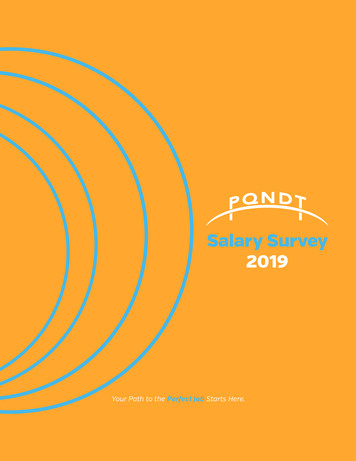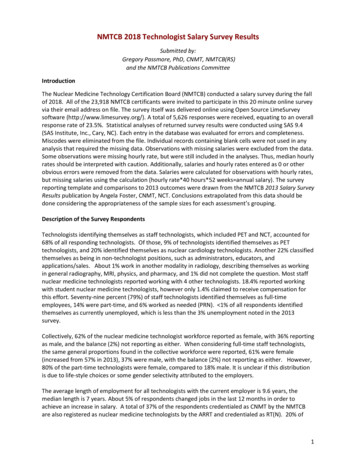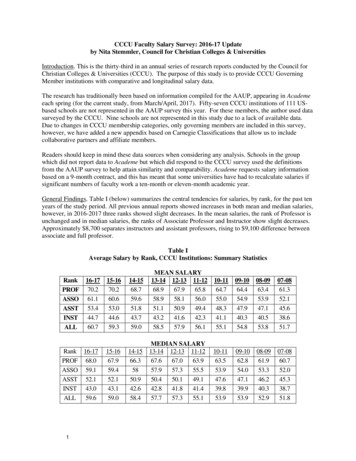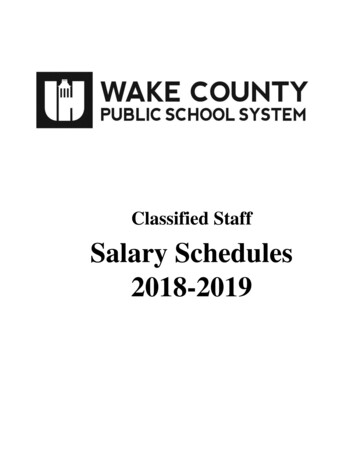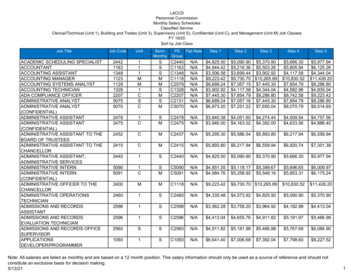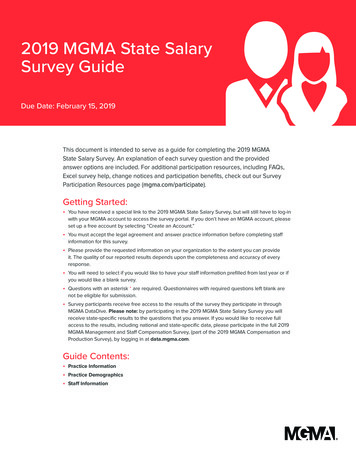
Transcription
2019 MGMA State SalarySurvey GuideDue Date: February 15, 2019This document is intended to serve as a guide for completing the 2019 MGMAState Salary Survey. An explanation of each survey question and the providedanswer options are included. For additional participation resources, including FAQs,Excel survey help, change notices and participation benefits, check out our SurveyParticipation Resources page (mgma.com/participate).Getting Started: You have received a special link to the 2019 MGMA State Salary Survey, but will still have to log-inwith your MGMA account to access the survey portal. If you don’t have an MGMA account, pleaseset up a free account by selecting “Create an Account.” You must accept the legal agreement and answer practice information before completing staffinformation for this survey. Please provide the requested information on your organization to the extent you can provideit. The quality of our reported results depends upon the completeness and accuracy of everyresponse. You will need to select if you would like to have your staff information prefilled from last year or ifyou would like a blank survey. Questions with an asterisk * are required. Questionnaires with required questions left blank arenot be eligible for submission. Survey participants receive free access to the results of the survey they participate in throughMGMA DataDive. Please note: by participating in the 2019 MGMA State Salary Survey you willreceive state-specific results to the questions that you answer. If you would like to receive fullaccess to the results, including national and state-specific data, please participate in the full 2019MGMA Management and Staff Compensation Survey, (part of the 2019 MGMA Compensation andProduction Survey), by logging in at data.mgma.com.Guide Contents: Practice Information Practice Demographics Staff Information
2019 MGMA State Salary Survey GuidePRACTICE INFORMATIONThis section must be completed fully before entering any staff information.*Practice NameEnter the practice name of the organization for which data is being reported.Practice AddressEnter the street address of the organization for which the data is being reported.Practice CityEnter the city of the organization for which the data is being reported.*Practice StateEnter the state of the organization for which the data is being reported.*Practice ZipEnter the zip code of the organization for which the data is being reported.*What type of organization do you work for?Select your work organization type from the list provided. If the type of work organization you workfor isn't listed, please select “Other” and enter the type of entity in the corresponding write-in field.Medical Group Practice: Physicians working in associations with the joint use of equipment andtechnical personnel and with centralized administration and financial organization.Hospital: A hospital is an inpatient facility that admits patients for overnight stays, incurs nursing carecosts, and generates bed-day revenues.Integrated Health System (IHS) or Integrated Delivery System (IDS): An IDS is a network oforganizations that provide or coordinate and arrange for the provision of a continuum of healthcareservices to consumers and is willing to be held clinically and fiscally responsible for the outcomesand the health status of the populations served. Generally consisting of hospitals, physician groups,health plans, home health agencies, hospices, skilled nursing facilities, or other provider entities,these networks may be built through "virtual" integration processes encompassing contractualarrangements and strategic alliances as well as through direct ownership.2
2019 MGMA State Salary Survey GuideManagement Services Organization (MSO): An MSO is an entity organized to provide various formsof practice management and administrative support services to healthcare providers. These servicesmay include centralized billing and collections services, management information services, and othercomponents of the managed care infrastructure. MSOs do not actually deliver healthcare services.MSOs may be jointly or solely owned and sponsored by physicians, hospitals or other parties. SomeMSOs also purchase assets of affiliated physicians and enter into long-term management servicearrangements with a provider network. Some expand their ownership base by involving outsideinvestors to help capitalize the development of such practice infrastructure.Physician Practice Management Company (PPMC): A PPMC is an entity that maintains full or partialownership interest in, and provides management services to, multiple physician organizations.PPMCs may own practices that span multiple specialties, or may be focused on a single specialtysuch as emergency medicine or hospital medicine.Independent Practice Association (IPA): An IPA is an association of independent physicians,or other organizations that contract with independent physicians, and provides services tomanaged care organizations on a negotiated per capita rate, flat retainer fee, or negotiatedfee-for-service basis.Health Maintenance Organization (HMO): An HMO is an insurance company that acceptsresponsibility for providing and delivering a predetermined set of comprehensive healthmaintenance and treatment services to a voluntarily enrolled population for a negotiated and fixedperiodic premium.Freestanding Ambulatory Surgery Center (ASC): An ASC is a freestanding entity that is specificallylicensed to provide surgery services that are performed on a same-day outpatient basis. Afreestanding ambulatory surgery center does not employ physicians and should not complete thesurvey. ASCs ARE NOT ELIGIBLE TO PARTICIPATE.Physician Hospital Organization (PHO): PHOs are group practice arrangements where hospitalsand physicians organize for contracting with managed care organizations. These relationships areformal, contractual, or corporate in nature and include physicians outside the hospital's medical staff.Medical School Administration (University Level): A medical school administration (university level)is a centralized administrative department which provides administrative services to multiple areasand departments within the university whole.Medical School Faculty Practice Plan: A medical school faculty practice plan is an organized groupof physicians and other healthcare professionals that treat patients referred to an academicmedical center.Medical School Clinical Science Department (Department Level): A medical school clinical sciencedepartment (department level) is a graduate school department within a university that offers studyleading to a medical degree.Medical School (School of Medicine Level): A medical school (school of medicine level) is agraduate school of medicine within a university that offers study leading to a medical degree.University Hospital: A university hospital (or teaching hospital) is a hospital that provides clinicaleducation and training to future and current doctors, nurses, and other health professionals, inaddition to delivering medical care to patients. They are generally affiliated with medical schoolsor universities, and may be owned by a university or may form part of a wider regional or nationalhealth system.Consulting Firm: A consulting firm is a person or group of persons who provide professional adviceto an organization for a fee.Recruitment Services Firm: A recruitment services firm is a person or group of persons who providerecruitment services to an organization for a fee.3
2019 MGMA State Salary Survey GuideOther: If your work organization is not listed, select “other” and enter the type of entity in thecorresponding write-in field.*Report Recipient EmailEnter the email address of the person who will receive access to the complimentary single-userreport. The email address must be associated with an MGMA account in order to grant access to theresults in MGMA DataDive.*Who is your practice’s majority owner?From the options listed, select the choice that represents the majority owner of your practice. If yourpractice’s ownership is not listed in the options provided, please select “Other” and enter the type ofentity in the corresponding write-in field.Physicians: Any doctor of medicine (MD) or doctor of osteopathy (DO) who is duly licensed andqualified under the law of jurisdiction in which treatment is received.Nonphysician Providers: Any nonphysician provider (e.g. nurse practitioners, physical therapists,etc.) who is duly licensed and qualified under the law of jurisdiction in which treatment is received.Hospital: A hospital is an inpatient facility that admits patients for overnight stays, incurs nursing carecosts, and generates bed-day revenues.Integrated Health System (IHS) or Integrated Delivery System (IDS): An IDS is a network oforganizations that provide or coordinate and arrange for the provision of a continuum of healthcareservices to consumers and is willing to be held clinically and fiscally responsible for the outcomesand the health status of the populations served. Generally consisting of hospitals, physician groups,health plans, home health agencies, hospices, skilled nursing facilities, or other provider entities,these networks may be built through "virtual" integration processes encompassing contractualarrangements and strategic alliances as well as through direct ownership.Management services organization (MSO): An MSO is an entity organized to provide various formsof practice management and administrative support services to healthcare providers. These servicesmay include centralized billing and collections services, management information services, and othercomponents of the managed care infrastructure. MSOs do not actually deliver healthcare services.MSOs may be jointly or solely owned and sponsored by physicians, hospitals or other parties. SomeMSOs also purchase assets of affiliated physicians and enter into long-term management servicearrangements with a provider network. Some expand their ownership base by involving outsideinvestors to help capitalize the development of such practice infrastructure.Physician practice management company (PPMC): A PPMC is an entity that maintains full or partialownership interest in, and provides management services to, multiple physician organizations.PPMCs may own practices that span multiple specialties, or may be focused on a single specialtysuch as emergency medicine or hospital medicine.Insurance company or health maintenance organization (HMO): An insurance company is anorganization that indemnifies an insured party against a specified loss in return for premiums paid, asstipulated by a contract. An HMO is an insurance company that accepts responsibility for providingand delivering a predetermined set of comprehensive health maintenance and treatment services toa voluntarily enrolled population for a negotiated and fixed periodic premium.University or medical school: A university is an institution of higher learning with teaching andresearch facilities comprising undergraduate, graduate and professional schools. A medical school isan institution that trains physicians and awards medical and osteopathic degrees.Government: A governmental organization at the federal, state, or local level. Government fundingis not a sufficient criterion. Government ownership is the key factor. An example would be a medicalclinic at a federal, state, or county correctional facility.4
2019 MGMA State Salary Survey GuidePrivate investor(s): A private investor is a company or individual that takes their own money anduses it to fund another organization. Some investors have the option to invest passively, whichmeans they give their funding and play no further role, while others have a more significant role inthe organization.Telehealth: A telehealth practice uses electronic information and telecommunication technologiesto support and deliver long-distance clinical healthcare, patient and professional health-relatededucation, public health, and health administration.Other: If your majority owner is not listed, select “other” and enter the type of entity in thecorresponding write-in field.*What is your practice’s practice or specialty type?From the options listed, select the practice type or single specialty that most closely describes yourpractice. If your single specialty is not listed, select "Other Single Specialty" and enter the specialtytype in the corresponding write-in field.PRACTICE DEMOGRAPHICSPractice NPI NumberThe National Provider Number (NPI) is a unique, 10-digit identification number assigned to healthcareproviders to submit claims or conduct other transactions specified by the Health InsurancePortability and Accountability Act (HIPAA). A healthcare provider is defined as an individual, group ororganization that provides medical or other health services. If you are unsure of your practice's NPInumber, you can look it up here: ySearch.do*For the purpose of reporting the information in thissurvey, what fiscal year was used?Enter the beginning month, beginning year, end month and end year of your most recentlycompleted fiscal year. Data reported for periods less than 12 months will not be eligible forsubmission. If your medical practice was involved in a merger or acquisition during the 2018 fiscalperiod and you cannot assemble 12 months of practice data, you may not be able to participate.Please contact Data Solutions at 877.275.6462, ext. 1895 or survey@mgma.com, if you are uncertainabout your eligibility to participate.*Beginning month: Enter the beginning month of your most recently completed fiscal year.*Beginning year: Enter the year that your most recently completed fiscal year began.*Ending month: Enter the ending month of your most recently completed fiscal year.*Ending year: Enter the year that your most recently completed fiscal year ended.*Total physician FTEReport the practice's full-time-equivalent (FTE) physician count. If an exact number is not known, abest estimate is acceptable.5
2019 MGMA State Salary Survey Guide*Total nonphysician provider FTEReport the number of FTE nonphysician providers in your practice. Nonphysician providers arespecially trained and licensed providers who can provide medical care and billable services.Examples of nonphysician providers include audiologists, certified registered nurse anesthetists(CRNAs), dieticians/ nutritionists, midwives, nurse practitioners, occupational therapists, optometrists,physical therapists, physician assistants, psychologists, and surgeon assistants.*Total support staff FTEReport the total support staff FTE in your practice. This should include business operations staff suchas managers or administrators, front office support staff, clinical support staff, ancillary support staff,and contracted support staff.*What was the total medical revenue for your practice ordepartment?Total medical revenue is the sum of fee-for-service collections (revenue collected from patientsand third-party payers for services provided to fee-for service, discounted fee-for-service, andnon-capitated Medicare/Medicaid patients), capitation payments (gross capitation revenue minuspurchased services for capitation payments), and other medical activity revenues.Other medical revenue includes grants, honoraria, research contract revenues, government supportpayments, and educational subsidies plus the revenue from the sale of medical goods and services.STAFF INFORMATIONInclude all managers and staff employed by the practice for the full fiscal year indicated in thePractice Demographics section, as well as any new hires during the same fiscal year. You mayinclude individuals that left the practice during the fiscal year, but you must select the correspondingemployment status for each individual and provide their hourly rate, if applicable. Enter eachmanager and staff on a separate row; do not group multiple individuals together on the same line,even if they have the same position title.*Staff NameEnter a unique name or ID for each manager or staff member. This may be the individual’s name,initials, last four numbers of SSN, or an internal code used to identify the individual. If we havequestions on your submission, we will refer to your staff by the name entered here.*Employment StatusAnswer "new hire" if the individual was hired by the practice during the reported fiscal year. Adjustthe full-time equivalent to be reflective of the hire date and do not annualize total compensation.An hourly rate must be reported, if applicable. Answer "Actively Employed" if the individual wasemployed for the full fiscal year. Answer "No longer employed" If the individual left the practice forany reason during the fiscal year. Adjust the full-time equivalent to be reflective of months worked.Do not annualize total compensation and report an hourly rate, if applicable.6
2019 MGMA State Salary Survey Guide*Position TitleSelect one position title that best describes each individual’s responsibilities from the list provided.Positions are listed in alphabetical order within each management level, which include physicianexecutives, executive management, senior management, general management, specialists,supervisors and support staff. If a position is not provided, select the appropriate "Other" optionand enter the position title in the corresponding write-in field. Please read the list of position titlescarefully before selecting an “other” option as those will not be included in any reported data.Other options are: “Other Executive”; “Other Director”; “Other Manager”; “Other Specialist”; “OtherSupervisor”; and “Other Staff.”Please note: There are no standard definitions for position titles in the industry. Our positiondescriptions are intended to be all encompassing. The more specific the position description, theless applicable it becomes to all participating practices and influences the amount of data reported.Please read the description and select the position title that most closely reflects the responsibilitiesof the employee.Select one of the following position titles for each individual staff:PHYSICIAN EXECUTIVE POSITIONS Associate/Assistant Medical Director:–– Position requires candidate to be a licensed physician;–– Time is devoted to both administrative duties and the delivery of healthcare services;–– Typically assists the medical director in all respects, from the administration of medical careand clinical services to utilization review and medical protocol development. If there aremultiple associate/assistant medical directors, the functional areas of medical administrationare usually divided up among physicians with this position title; and–– Usually reports to the senior physician executive. Chief Medical Officer (CMO):–– Elected by the medical staff and acts as a liaison between the medical staff andadministration;–– Ensures that projects and policies are completed in a timely manner;–– Principle duty is to ensure that the executive decisions are carried out and oversee that staffmembers follow these guidelines;–– Typically, a one to two-year term;–– Required to be a licensed physician; and–– Usually reports to the senior physician executive. Chief Medical Informatics Officer (CMIO):–– Develops and manages the organization’s capabilities in information systems and tools thatare applied to medical information;–– Coordinates analytical support for medical management, including profiling, health economicsand business analytics/performance metrics;–– Works with the Information Systems Department to prioritize medical management needs; and–– Usually reports to the senior executive manager.7
2019 MGMA State Salary Survey Guide Medical Director:–– Position requires candidate to be a licensed physician;–– The senior medical administrative position within a medical group practice;–– Physician’s time is devoted to both administrativ
2019 MGMA State Salary Survey Guide Due Date: February 15, 2019 This document is intended to serve as a guide for completing the 2019 MGMA State Salary Survey. An explanation of each survey que
